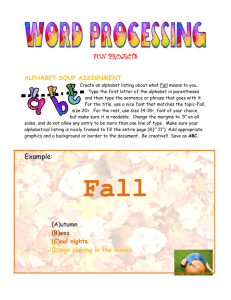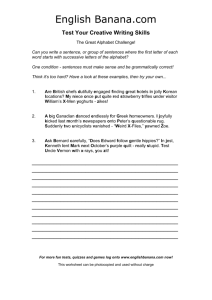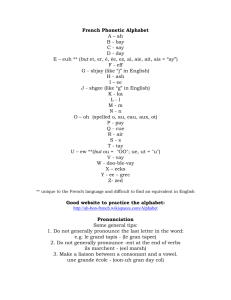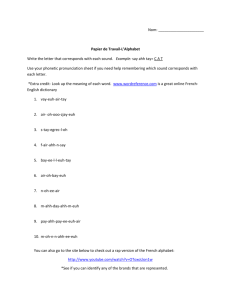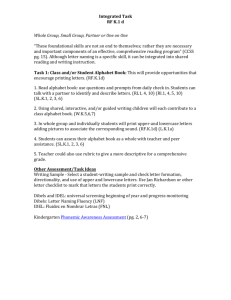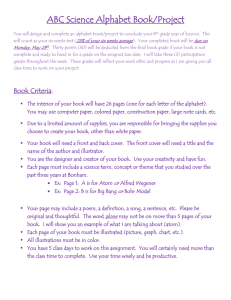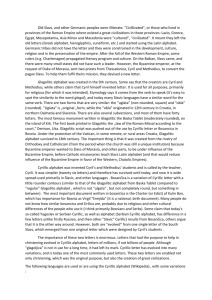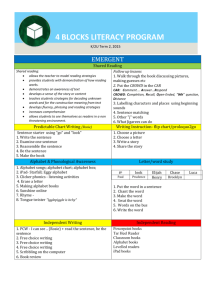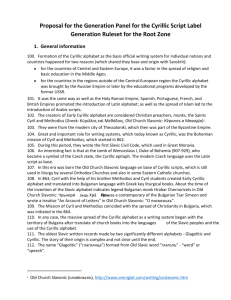RUSSIAN LANGUAGE: A BRIEF HISTORY
advertisement
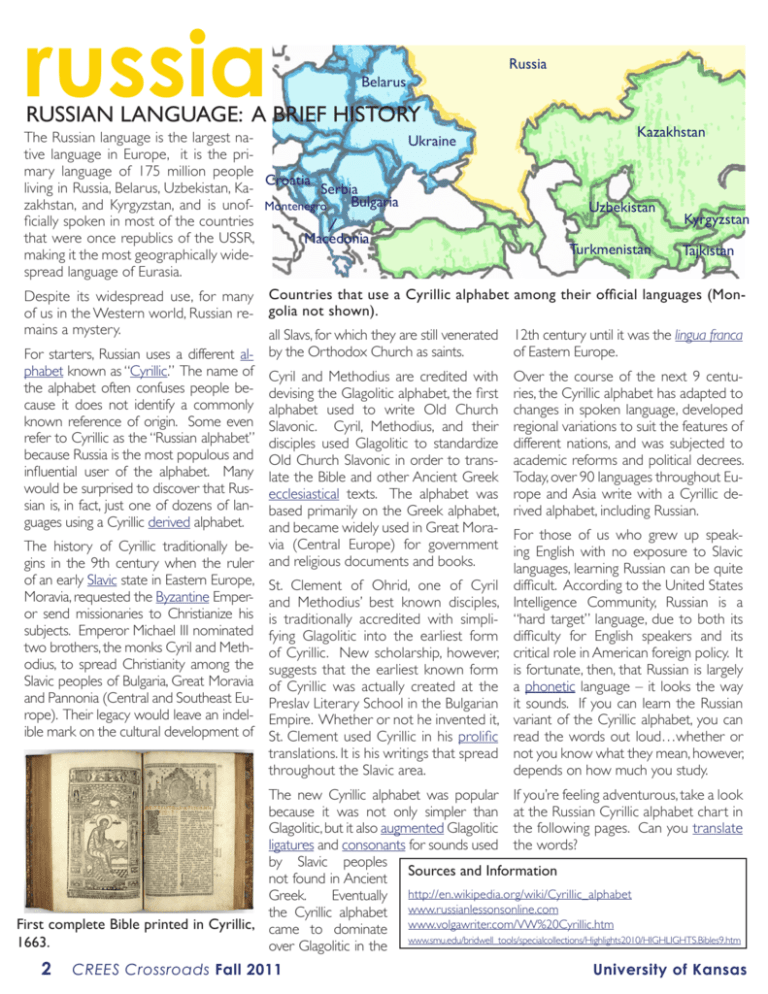
russia Russia Belarus RUSSIAN LANGUAGE: A BRIEF HISTORY The Russian language is the largest naUkraine tive language in Europe, it is the primary language of 175 million people Croatia living in Russia, Belarus, Uzbekistan, KaSerbia Bulgaria zakhstan, and Kyrgyzstan, and is unof- Montenegro ficially spoken in most of the countries that were once republics of the USSR, Macedonia making it the most geographically widespread language of Eurasia. Kazakhstan Uzbekistan Turkmenistan Kyrgyzstan Tajkistan Despite its widespread use, for many Countries that use a Cyrillic alphabet among their official languages (Monof us in the Western world, Russian re- golia not shown). mains a mystery. all Slavs, for which they are still venerated 12th century until it was the lingua franca of Eastern Europe. For starters, Russian uses a different al- by the Orthodox Church as saints. phabet known as “Cyrillic.” The name of Cyril and Methodius are credited with Over the course of the next 9 centuthe alphabet often confuses people be- devising the Glagolitic alphabet, the first ries, the Cyrillic alphabet has adapted to cause it does not identify a commonly alphabet used to write Old Church changes in spoken language, developed known reference of origin. Some even Slavonic. Cyril, Methodius, and their regional variations to suit the features of refer to Cyrillic as the “Russian alphabet” disciples used Glagolitic to standardize different nations, and was subjected to because Russia is the most populous and Old Church Slavonic in order to trans- academic reforms and political decrees. influential user of the alphabet. Many late the Bible and other Ancient Greek Today, over 90 languages throughout Euwould be surprised to discover that Rus- ecclesiastical texts. The alphabet was rope and Asia write with a Cyrillic desian is, in fact, just one of dozens of lan- based primarily on the Greek alphabet, rived alphabet, including Russian. guages using a Cyrillic derived alphabet. and became widely used in Great Mora- For those of us who grew up speakThe history of Cyrillic traditionally be- via (Central Europe) for government ing English with no exposure to Slavic gins in the 9th century when the ruler and religious documents and books. languages, learning Russian can be quite of an early Slavic state in Eastern Europe, St. Clement of Ohrid, one of Cyril difficult. According to the United States Moravia, requested the Byzantine Emper- and Methodius’ best known disciples, Intelligence Community, Russian is a or send missionaries to Christianize his is traditionally accredited with simpli- “hard target” language, due to both its subjects. Emperor Michael III nominated fying Glagolitic into the earliest form difficulty for English speakers and its two brothers, the monks Cyril and Meth- of Cyrillic. New scholarship, however, critical role in American foreign policy. It odius, to spread Christianity among the suggests that the earliest known form is fortunate, then, that Russian is largely Slavic peoples of Bulgaria, Great Moravia of Cyrillic was actually created at the a phonetic language – it looks the way and Pannonia (Central and Southeast Eu- Preslav Literary School in the Bulgarian it sounds. If you can learn the Russian rope). Their legacy would leave an indel- Empire. Whether or not he invented it, variant of the Cyrillic alphabet, you can ible mark on the cultural development of St. Clement used Cyrillic in his prolific read the words out loud…whether or translations. It is his writings that spread not you know what they mean, however, throughout the Slavic area. depends on how much you study. The new Cyrillic alphabet was popular If you’re feeling adventurous, take a look because it was not only simpler than at the Russian Cyrillic alphabet chart in Glagolitic, but it also augmented Glagolitic the following pages. Can you translate ligatures and consonants for sounds used the words? by Slavic peoples Sources and Information not found in Ancient Greek. Eventually http://en.wikipedia.org/wiki/Cyrillic_alphabet the Cyrillic alphabet www.russianlessonsonline.com First complete Bible printed in Cyrillic, came to dominate www.volgawriter.com/VW%20Cyrillic.htm 1663. over Glagolitic in the www.smu.edu/bridwell_tools/specialcollections/Highlights2010/HIGHLIGHTS.Bibles9.htm 2 CREES Crossroads Fall 2011 University of Kansas lesson plan alphabet soup! Created by: Adrienne Landry, CREES Outreach Coordinator Subject: World Cultures, Foreign Languages, World History Grade: 4th - 12th Overview The modern Russian alphabet is a variant of the Cyrillic alphabet and contains 33 letters. To non-native speakers, it may look intimidating, but it’s actually quite easy to learn! In this activity, students will compare Russian and English letters and their sounds. They will then use this knowledge to fill out a worksheet identifying American geographical locations by their Russian language cognates. Objectives Student will be able to: • Identify all 33 letters of the Russian alphabet; • Pronounce 33 letters of the Russian alphabet; • Use the Russian alphabet to spell out American geographical locations. Materials All materials are included in this lesson plan. Activities Introduce students to the Russian language by reading outloud the attached article “Russian Language: A Brief History.” Give an overview of the Russian alphabet (provided on page 4). Show students the chart of the Russian alphabet and its equivalent English letters and sounds. Sound out all 33 letters of the alphabet together. Explain that “cognates” are words in two languages that share a similar meaning, spelling and pronounciation. Give examples from the worksheet (“Russians pronounce ‘America’ same as we do, even if their writing of it looks different!”) Ask students to fill in the attached worksheet using the Russian alphabet chart as a key. Encourage students to find the English letter equivalent to the Cyrillic, and to not focus on pronunciation until after they have spelled the word out. Adaptations This lesson can be used for younger grades, although the teacher will need to help with the spelling of American geographical locations. University of Kansas RUSSIAN CYRILLIC EDITION To make the lesson more challenging, have students read the article and identify suggested vocabulary words. Evaluations Assessment of the student’s capability of identifying Russian alphabet letters will be determined by how many answers they get correct on the attached worksheet. Additional Resources A useful website for teaching Russian language can be found at: www.russianlessonsonline.com Here you will find interactive video and audio resources for learning and teaching Russian Cyrillic. Some of the website’s resources, like the “History of the Cyrillic Alphabet” video should be viewed critically as it is entirely over simplified and even inaccurate at certain points. That said, it is a fun cartoon that is easily accessible for younger students and may work as an easy introduction to Slavic languages. Vocabulary: Alphabet Augment Byzantine Cyrillic Cognate Consonant Derive Ecclesiastical Ligature Lingua Franca Phonetic Prolific Slavic Translate Students may also enjoy a Russian Sesame Street version of the “Alphabet Song.” Extra Credit Offer extra credit to students who are able to figure out how to spell their name and/or hometown in Russian using the chart.. CREES Crossroads Fall 2011 3 cyrillic alphabet chart Many letters in the Russian alphabet are pronounced the same as letters in the English alphabet, while some are entirely unique sounds. There are even some letters in the Russian alphabet that make no sound at all – rather they indicate how the letter before them should be pronounced. Follow the chart and pronounce as many of the Russian letters as you can out loud! * Indicates no comparable English letter. For help with pronunciation, visit Language Helpers and click on each letter to hear how the letter is pronounced. 4 Russian Letter English Letter English Pronunciation У * oo Ф F eff Х * kh Russian Letter English Letter English Pronunciation Russian Letter English Letter English Pronunciation A A ah Й Y yih Ц * ts Б B beh К K kah Ч * ch В V veh Л L Ш * sh Г G geh М M em Щ * shch Д D deh Н N en Ъ * hard sign Е E yeh О O oh Ы * y Ё * yoh П P peh Ь * soft sign Ж J zheh Р R err Э * eh З Z zeh С S ess Ю * you И I ee Т T teh Я * ya CREES Crossroads Fall 2011 ell University of Kansas WORKSHEET russian alphabet soup! Имя (Name): The following are all states and cities in the United States, only they are written in Russian. Can you translate them? Fill out the answers using the Russian Cyrillic Alphabet Chart. Find the English letter equivalents! Example: АМЕРИКА = America 1. КАНЗАС 11. САН ФРАНЦИСКО 2. ВАШИНГТОН 12. ЛОС АНДЖЕЛЕС 3. МОНТАНА 13. ЮТА 4. КЕНТУКИ 14. ФИЛАДЕЛЬФИЯ 5. КАНЗАС СИТИ 15. КАЛИФОРНИЯ 6. БОСТОН 16. МИССУРИ 7. ЦИНЦИННАТИ 17. НЬЮ ЙОРК 8. ЧИКАГО 18. МИЧИГАН 9. АРКАНЗАС 19. КОЛОРАДО 10. НЕБРАСКА 20. МИССИСИПИ Answer Key: 1. Kansas; 2. Washington; 3. Montana; 4. Kentucky; 5. Kansas City; 6. Boston; 7. Cincinnati; 8. Chicago; 9. Arkansa; 10. Nebraska; 11. San Francisco; 12. Los Angeles; 13. Utah; 14. Philadelphia; 15. California; 16. Missouri; 17. New York; 18. Michigan; 19. Colorado; 20. Mississippi. University of Kansas CREES Crossroads Fall 2011 5


